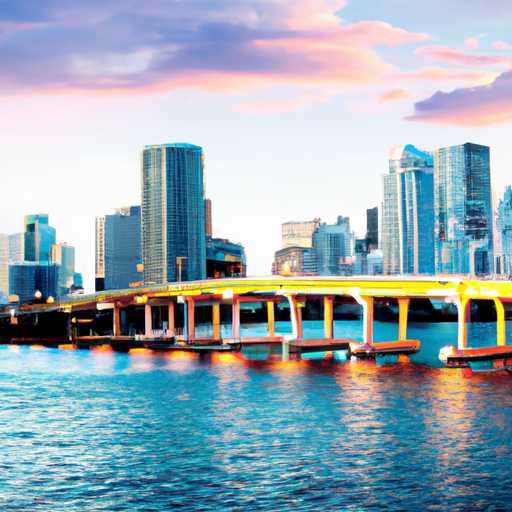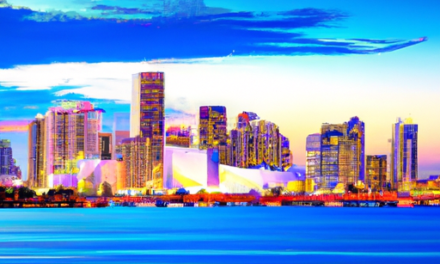Have you ever wondered how Miami got its name? In this article, we will briefly delve into the origins of Miami’s name and explore the history behind it. You’ll learn about the influences that led to the naming of this vibrant city in Florida.
Miami’s name has its roots in the Native American language. The city’s name comes from the Mayaimi tribe, who were Native Americans living in the region centuries ago. The word “Mayaimi” translates to “big water” or “sweet water” in the language of the tribe. This is believed to refer to Lake Okeechobee, the largest freshwater lake in Florida, which was once an important part of the Mayaimi tribe’s territory. Over time, the name evolved into “Miami” as it became anglicized, and the city came to be known as Miami. Miami, a vibrant and diverse city located in the southeastern region of the United States, has a rich and fascinating history that is closely tied to its name. In this article, we will explore the origins of Miami’s name, its historical significance, and the influence it has had on the city to this day.
History of Miami
Miami’s history dates back to early settlements in the area, long before European explorers arrived on its shores. Native American tribes, including the Tequesta and the Seminole, inhabited the region and left their mark on the land.
Early settlements in the area
Before the arrival of Europeans, the Miami area was home to several Native American settlements. These early inhabitants thrived in the region’s fertile lands and abundant wildlife, establishing villages along the Miami River and the surrounding areas.
The influence of Native American tribes
The Native American tribes who lived in the Miami area played a significant role in shaping its culture and traditions. Their presence can still be felt today through various art forms, such as pottery, basket weaving, and storytelling, as well as in the city’s vibrant festivals and celebrations.
Spanish colonization and naming of the region
In the late 15th century, Spanish explorers arrived in the region, seeking new lands to colonize and resources to exploit. It was during this time that the region now known as Miami came to be named.
Origin of the Name Miami
The etymology of the word “Miami” traces back to the Native American origins of the region. The name is believed to be derived from the Mayaimi tribe, who inhabited the area and were part of the larger Tequesta tribe.
Native American origins and meanings
The word “Miami” is thought to have multiple possible meanings in the Tequesta language. One interpretation suggests that it may mean “big water” or “sweet water,” referring to the abundant water sources found in the area, such as the Miami River and the Biscayne Bay.
Influence of early Spanish explorers
When Spanish explorers first encountered the Native American inhabitants of the Miami area, they referred to them as the “Mayaimi.” Over time, this name became associated with the entire region, and it eventually became the official name for the area.
Exploration and Settlement
As European exploration of North America continued, more expeditions arrived in the Miami area, leading to the establishment of permanent settlements.
Early European explorers in the region
In the early 16th century, Spanish explorers such as Juan Ponce de León and Pedro Menéndez de Avilés explored the coast of Florida, including the Miami area. However, it wasn’t until the early 19th century that the region saw significant European settlement.
Founding of the Miami River settlement
The modern-day city of Miami traces its roots back to the founding of the Miami River settlement in 1836 by William and Mary Brickell. The settlement initially served as a trading post and quickly grew into a prosperous community, attracting settlers from all over the United States.
Growth and development in the 19th century
Throughout the 19th century, the Miami area experienced steady growth and development. The arrival of Henry Flagler’s Florida East Coast Railway in the early 20th century further accelerated the city’s expansion, connecting it to other major cities in Florida and facilitating the transportation of goods and people.
Growth and Influence
Miami’s growth and influence can be attributed to a series of key events and factors that shaped its history.
Key events in Miami’s history
Several key events have marked Miami’s history and contributed to its growth. These include the construction of the Royal Palm Hotel in 1896, which attracted wealthy visitors, as well as the opening of the Panama Canal in 1914, which further boosted Miami’s trade and tourism industries.
Immigration and cultural diversity
Miami’s cultural diversity is a result of its rich history of immigration. In the early 20th century, many immigrants, particularly from Cuba and other Latin American countries, flocked to Miami, seeking opportunities and a better life. This influx of immigrants has greatly influenced the city’s culture, cuisine, and language.
Impact of the railroad and industrialization
The construction of the Florida East Coast Railway not only brought economic prosperity to Miami but also fueled the city’s industrialization. The railroad facilitated the transportation of goods, allowing Miami to become a major hub for trade and commerce in the region.
Development into a City
Miami officially became a city in 1896, marking a significant milestone in its history.
Incorporation of the City of Miami
On July 28, 1896, the City of Miami was officially incorporated, with Julia Tuttle as its first and only female founder. This marked the beginning of a new era for Miami, as it transformed from a small settlement into a bustling city.
Boom period in the early 20th century
The early 20th century was a period of remarkable growth and prosperity for Miami. The city experienced a real estate boom, attracting investors and developers who wanted to capitalize on its tropical climate, beautiful beaches, and growing population.
Urban development and infrastructure
To support its growing population and booming tourism industry, Miami underwent significant urban development in the 20th century. Modern infrastructure, including highways, bridges, and an international airport, transformed the city into a major transportation hub.
Tourism and Leisure
Miami’s unique blend of natural beauty, cultural diversity, and vibrant atmosphere has made it a popular tourist destination.
Emergence of Miami as a tourist destination
In the early 20th century, Miami’s pristine beaches and warm climate began to attract tourists from around the world. The city’s reputation as a tropical paradise only grew with the development of luxurious resorts and the rise of air travel, making it easily accessible to visitors from all corners of the globe.
The impact of Art Deco architecture
One of Miami’s most iconic features is its collection of Art Deco architecture, predominantly found in the city’s famous South Beach district. The colorful buildings of the Art Deco Historic District draw tourists and locals alike, showcasing the city’s unique blend of history and contemporary allure.
Legendary resorts and attractions
Throughout its history, Miami has been home to legendary resorts and attractions, which have played a significant role in shaping the city’s image. From the Fontainebleau Miami Beach to the renowned Vizcaya Museum and Gardens, Miami offers a wide range of experiences for visitors of all interests.
Modern Miami
Today, Miami is a thriving metropolis with a global reputation as a business hub and a cultural hotbed.
City’s role as a global business hub
Miami’s strategic location, burgeoning economy, and diverse workforce have positioned it as a leading business center in the Americas. The city is home to numerous multinational corporations, financial institutions, and trade organizations, making it a key player in the global economy.
Cultural and artistic vibrancy
Miami’s cultural scene is vibrant and diverse, offering a wide range of artistic experiences. The city boasts world-class museums, galleries, and performing arts centers, showcasing everything from traditional Latin American art to contemporary exhibits.
Challenges in urban planning and sustainability
As Miami continues to grow, it faces numerous challenges in terms of urban planning and sustainability. Rising sea levels, hurricanes, and overdevelopment have led to concerns about the city’s long-term viability. Efforts are underway to address these challenges through sustainable initiatives and urban planning strategies.
Miami’s Name Today
The name Miami holds significant cultural, historical, and economic significance for the city today.
Perception and significance of the name Miami
The name Miami is widely recognized and associated with a vibrant, multicultural city that embodies the spirit of the Sunshine State. It evokes images of palm-fringed beaches, vibrant nightlife, and a thriving arts scene, making it a desirable destination for tourists and residents alike.
Native American heritage and pride
Miami’s name serves as a reminder of its Native American heritage and the contributions of the indigenous tribes who first inhabited the region. The city embraces and celebrates its diverse cultural roots, aiming to preserve and honor the legacy of the Native American communities.
Promotion of the city’s brand
Miami’s name has become synonymous with a certain lifestyle and image, which has been strategically marketed and promoted to a global audience. The city’s brand reflects its unique blend of natural beauty, cultural diversity, and vibrant energy, attracting tourists, businesses, and investors from around the world.

Conclusion
Miami’s name is intertwined with its rich historical tapestry, reflecting the city’s diverse cultural heritage and its journey from a Native American settlement to a bustling metropolis. From its origins as a trading post along the Miami River to its emergence as a global business hub, the name Miami has become synonymous with success, vibrancy, and opportunity. As Miami continues to evolve, its name will continue to hold cultural, historical, and economic significance, serving as a reminder of the city’s remarkable journey and its bright future. So the next time you visit Miami, take a moment to appreciate its name and all the stories it holds.








